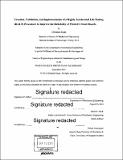Creation, validation, and implementation of a Highly Accelerated Life Testing (HALT) procedure to improve the reliability of printed circuit boards
Author(s)
Singh, Abhishek, M. Eng. Massachusetts Institute of Technology
DownloadFull printable version (18.49Mb)
Alternative title
Creation, validation, and implementation of a HALT procedure to improve the reliability of PCBs
Other Contributors
Massachusetts Institute of Technology. Department of Mechanical Engineering.
Advisor
David E. Hardt.
Terms of use
Metadata
Show full item recordAbstract
Highly Accelerated Life Testing (HALT) is a test methodology to evaluate the reliability of electronic and electromechanical devices. This thesis aimed at the implementation of Highly Accelerated Life Testing (HALT) on Printed Circuit Boards. A standard operating procedure for implementing Highly Accelerated Life Testing (HALT) to increase the reliability of PCBs used in various Waters equipment is developed and validated. For the creation of the standard operating procedure a very reliable Alliance PCB is selected that acts as a benchmark for screening other boards. Extensive testing is done on the Alliance PCB by subjecting it to thermal and vibration stresses through a Hot Step Stress profile, Cold Step Stress profile, Thermal Cycling, Vibration Step Stress profile and Combined Cycle profile. For validation, the standard operating procedure created is applied to a less reliable Acquity board to check whether the same standard operating procedure is effective in precipitating and detecting failures on a variety of different boards that Waters equipment uses. As expected the operating limits of temperature and vibration of the Acquity board are found to be less than the Alliance board i.e. the Acquity experiences failure much earlier than Alliance when subjected to the same stress profiles. This result is in direct correlation with the on field failure data obtained for these two boards - the less reliable board has lesser operating limits.
Description
Thesis: M. Eng. in Advanced Manufacturing and Design, Massachusetts Institute of Technology, Department of Mechanical Engineering, 2016. Cataloged from PDF version of thesis. Includes bibliographical references (pages 98-99).
Date issued
2016Department
Massachusetts Institute of Technology. Department of Mechanical EngineeringPublisher
Massachusetts Institute of Technology
Keywords
Mechanical Engineering.